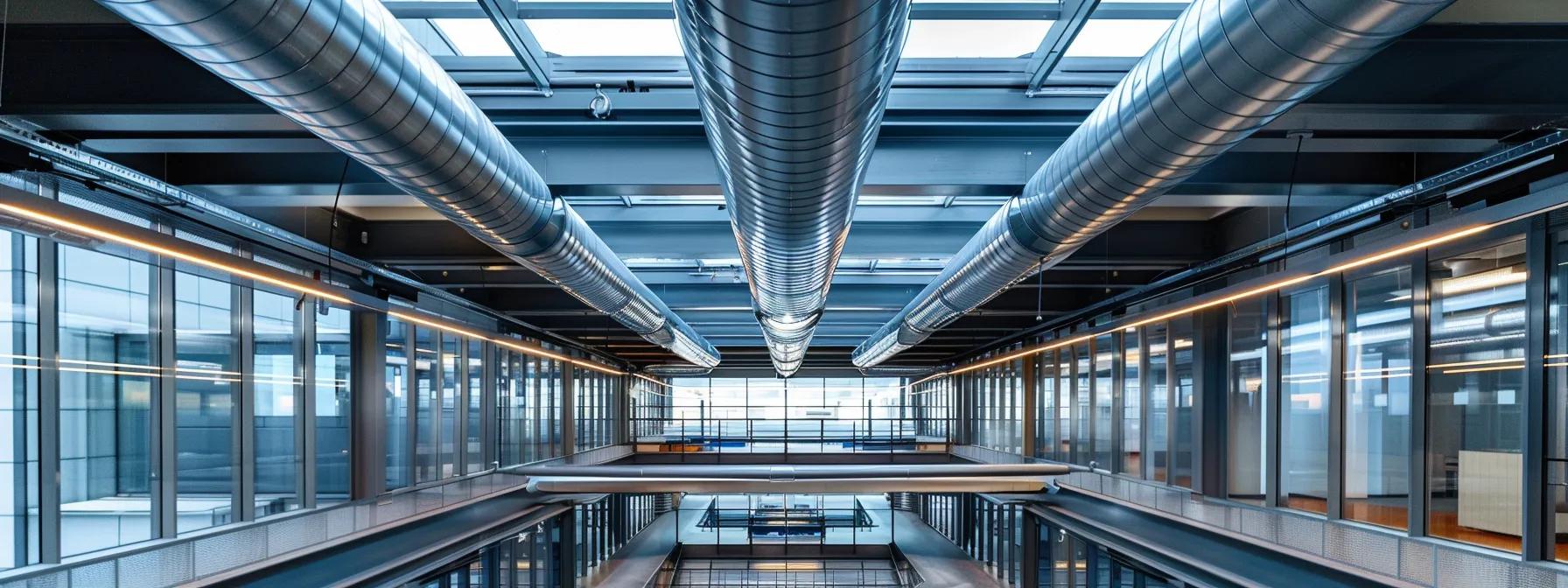
Comprehensive Guide to HVAC Duct Work: Installation, Repair, Cleaning, and Energy Efficiency
In modern buildings, HVAC duct work plays a vital role in creating a comfortable and healthy indoor environment by distributing heated and cooled air throughout a structure. This comprehensive guide examines HVAC duct work—from its definition and benefits to installation processes, repair procedures, cleaning schedules, and energy efficiency strategies. Homeowners, facility managers, and building professionals will gain insights on how proper duct installation and maintenance improve indoor air quality, reduce energy costs, and ensure optimal HVAC performance. The article explains why duct work is essential and provides actionable steps for identifying and repairing common problems while reviewing the newest trends, materials, and contractor selection tips. Let’s explore the multifaceted world of HVAC duct systems and discover practical solutions to enhance indoor comfort and energy conservation.
What Is HVAC Duct Work and Why Is It Important?
HVAC duct work is the network of passages that distribute conditioned air throughout a building, ensuring efficient operation of heating and cooling systems. These systems provide a controlled pathway for air circulation, directly influencing indoor air quality, overall comfort, and energy use. Ducts are typically made from sheet metal, fiberboard, or other durable materials. When properly designed and maintained, HVAC duct work promotes even temperature distribution, reduces the strain on HVAC components, and mitigates health risks related to dust accumulation and mold buildup. Additionally, eliminating air leaks through proper sealing helps prevent energy waste and high utility bills; studies show that sealed duct systems can improve energy savings by up to 20%.
How Does HVAC Duct Work Affect Indoor Air Quality?
A well-sealed and maintained duct system minimizes the entry of pollutants such as dust, pollen, and microbial contaminants into living spaces. Regular inspections and cleaning routines help prevent ducts from becoming a source of indoor pollution due to accumulated dirt or leaks. Enhanced ventilation achieved by properly maintained ducts can reduce allergens by approximately 15%–30%, thereby improving respiratory comfort and lowering the risk of conditions related to poor indoor air quality.
What Role Does HVAC Duct Work Play in Energy Efficiency?
The efficiency of an HVAC system depends heavily on the integrity of its duct work. Well-insulated and airtight ducts direct conditioned air where it is needed without unnecessary loss. In a properly installed system, duct insulation and sealing reduce energy waste, leading to significant cost savings on utility bills. Faulty or leaking ducts can result in energy losses of 20% or more, whereas well-maintained ducts help lower the carbon footprint associated with heating and cooling operations.
What Are the Common Types of HVAC Ductwork Materials?
HVAC ductwork can be built from various materials: – Sheet metal ductwork: Durable, long-lasting, and commonly used in commercial and industrial settings. – Flexible ductwork: A pliable option often used in residential installations; however, it may sag if not properly supported. – Fiberglass-lined ducts: Combine metal durability with an insulating inner lining, improving sound dampening. – Fiberboard ducts: Cost-effective for residential use but require careful sealing to prevent moisture issues. – Plastic or PVC ducts: Suitable for specific applications needing resistance to corrosion or chemical exposure.
The choice among these materials depends on the building’s specific requirements, desired insulation levels, and anticipated maintenance needs.
How Is HVAC Duct Work Installed? Step-by-Step Process and Considerations
Proper installation of HVAC duct work involves careful planning, material selection, precise measurements, and expert workmanship. The process starts with designing a duct layout based on the building’s air distribution requirements. Qualified technicians perform load calculations to determine the optimal duct sizes and then inspect building plans and spaces like attics or crawl spaces to choose appropriate materials. Specialized tools secure duct fittings and ensure proper alignment with HVAC units. This systematic approach—which includes sealing all joint connections—minimizes the risk of leaks and obstructions and significantly reduces long-term maintenance issues.
What Are the Best Materials for HVAC Duct Installation?
Choosing the best materials for installation depends on the application, environmental factors, and budget. Often, flexible metal ducts are used for areas with curves and tight spaces, while rigid sheet metal ducts provide superior longevity and minimal air leakage when properly sealed. Fiberglass-lined ducts add thermal insulation and noise reduction benefits. Frequently, an ideal installation combines rigid ductwork for long runs with flexible connectors in awkward spaces to ensure optimal airflow.
How Does Residential HVAC Duct Installation Differ From Commercial?
Residential installations usually involve smaller systems, with an emphasis on energy efficiency, quiet operation, and visual integration into living spaces. In contrast, commercial projects must handle larger air volumes and adhere to stricter building codes and energy standards. Commercial installations often require high-performance materials and more complex coordination between systems. Thus, choosing an experienced contractor familiar with the specific demands of residential or commercial projects is critical.
What Factors Influence HVAC Duct Installation Cost?
Several factors influence installation costs including building size, duct layout complexity, and material choices. Labor rates, custom fabrication needs, insulation, and noise control features can also affect pricing. Older buildings may need retrofitting, adding to the expense. On average, proper HVAC duct installation is estimated at around $3 to $7 per linear foot. Comparing quotes from qualified contractors can help ensure that the long-term energy savings and reduced maintenance justify the initial investment.
How Do You Identify and Repair Common HVAC Duct Work Problems?
Routine inspections are crucial for identifying HVAC duct work problems before they escalate. Common indicators include: – Visible leaks or damage – Inconsistent airflow among rooms – Unusual noises such as hissing or rattling – Accumulation of dust or debris near duct joints
Prompt diagnosis using tools like thermal imaging cameras, flow meters, or pressure gauges can help locate issues accurately.
What Are the Signs of Damaged or Leaking Ductwork?
Signs of damage include uneven airflow, unexpected spikes in energy bills, and audible hissing or rattling sounds. Dust and moisture accumulation around ducts can further indicate leaks and potential mold growth. Early detection is essential to maintain HVAC efficiency and prevent health hazards associated with poor air quality.
How Is Ductwork Leak Repair Performed?
Leak repairs begin with pinpointing the location of the problem using diagnostic tools. After cleaning the affected area, technicians apply high-quality HVAC duct sealants or mastic compounds to secure an airtight seal. In severe cases, replacing compromised duct sections may be necessary. Effective repair restores system performance, reduces energy loss, and helps avoid secondary issues such as mold growth.
What Is the Typical Cost of HVAC Ductwork Repair?
Repair costs vary with damage extent, material quality, and labor rates. Minor repairs may range from $200 to $500, while extensive restorations can cost $1,000 to $2,500. Although such repairs can seem costly, timely maintenance can ultimately save money by preventing larger system failures and reducing ongoing energy losses.
When and How Should HVAC Duct Work Be Cleaned and Maintained?
Regular cleaning and maintenance are essential to sustain optimal HVAC performance, indoor air quality, and system longevity. Scheduled maintenance typically involves periodic inspections, dust and debris cleaning, and checking for mold or moisture buildup. Professional cleaning can remove up to 95% of dust accumulation, which improves air quality and reduces the risk of contamination. Establishing a maintenance routine, tailored to the building’s usage and environmental conditions, minimizes the likelihood of costly repairs later on.
How Often Should HVAC Ducts Be Cleaned for Optimal Air Quality?
For most settings, cleaning HVAC ducts every three to five years is sufficient. However, areas with high dust, allergen, or moisture levels may benefit from cleaning every two years. Renovations or visible signs of dust and mold further indicate the need for more frequent cleaning to ensure proper airflow and system efficiency.
What Are the Benefits of Regular Duct Cleaning and Maintenance?
Regular cleaning offers improved indoor air quality, enhanced system efficiency, and extended equipment lifespan. Removing contaminants like dust and allergens reduces respiratory irritations and lessens the workload on HVAC components, ultimately lowering energy consumption and maintenance costs.
How Is Mold Removed From HVAC Ductwork?
Mold remediation involves a detailed inspection to assess contamination levels using moisture meters and thermal imaging. Affected sections are sealed off to prevent cross-contamination, followed by treatment with antifungal cleaners and biocides approved for HVAC systems. In cases of severe mold presence, replacing contaminated duct sections may be necessary. Addressing mold promptly restores air quality and prevents future recurrence.
How Can HVAC Duct Work Improve Energy Efficiency and Reduce Utility Bills?
Efficient duct work is key to ensuring that conditioned air is delivered where needed without unnecessary loss. Sealing leaks, optimizing duct layout, and adding proper insulation all contribute to reducing energy waste. With improved airflow and reduced strain on HVAC units, energy savings of up to 20% are possible. This not only leads to lower operating costs but also contributes to a reduced carbon footprint, aligning with green building standards.
What Is Duct Sealing and How Does It Save Energy?
Duct sealing involves closing gaps and joints in ductwork with specialized sealants and tapes. This step is critical because even small air leaks can lead to significant energy losses over time. Sealed ducts ensure that all heated or cooled air reaches its destination efficiently, easing the load on HVAC systems and offering measurable energy savings of 15%–20%.
How Does Duct Insulation Enhance HVAC Performance?
Insulating ducts minimizes thermal losses as conditioned air moves through the system. This helps maintain the intended air temperature, reducing the energy required to reheat or recool air. Effective insulation also reduces noise and prevents condensation, contributing to a quieter and more reliable HVAC operation while lowering utility bills.
What Are the Latest Trends in Energy-Efficient Ductwork Materials?
Recent trends emphasize sustainability and performance improvements in ductwork. High-performance flexible ducts with enhanced sealing properties, advanced metal alloys resistant to corrosion, and eco-friendly insulation materials are gaining popularity. Manufacturers are also integrating smart monitoring technologies that adjust duct performance in real time, further optimizing energy usage and reducing maintenance costs.
What Are the Most Frequently Asked Questions About HVAC Duct Work?
This section addresses common questions regarding HVAC duct work, offering concise, factual answers to help customers understand the importance of well-maintained duct systems and make informed decisions about installation, repair, and maintenance.
How Much Does HVAC Duct Work Cost on Average?
Costs vary by building size, material quality, and system complexity. For a standard residential installation, duct work typically ranges from $3 to $7 per linear foot, with repair and cleaning services adding extra expenses. Commercial projects may be higher due to larger scale and specialized requirements.
How Do I Find Reliable HVAC Duct Work Services Near Me?
Reliable services can be found by researching local contractors, reading customer reviews, and verifying industry certifications (such as those from SMACNA). Recommendations from friends or local business networks and comparing multiple quotes can help ensure you hire a skilled and reputable contractor.
What Are the Health Risks of Poorly Maintained Ductwork?
Poor maintenance can compromise indoor air quality by allowing dust, allergens, and mold to circulate, potentially triggering respiratory issues and allergies. Regular inspections and cleaning are crucial to maintaining healthy indoor air and preventing contamination-related health hazards.
How to Choose the Right HVAC Contractor for Your Duct Work Needs?
Selecting a capable HVAC contractor is key to ensuring quality duct installation, repair, and maintenance. Look for professionals with proven expertise, proper certifications, solid reputations, and a history of meeting building codes and energy efficiency standards. Obtaining multiple quotes and customer testimonials can further guide your decision-making process.
What Qualifications Should an HVAC Technician Have?
Technicians should have formal HVAC training, practical experience through apprenticeships or on-the-job training, and certifications such as those from North American Technician Excellence (NATE). Ongoing education is also important to keep up with industry advancements and evolving standards.
Why Is Experience Important in HVAC Duct Installation and Repair?
Experience is crucial for accurately diagnosing issues, implementing effective repairs, and anticipating potential problems. Skilled contractors familiar with different building types and duct materials can optimize airflow, reduce leaks, and ensure long-term, cost-effective performance.
How Can Customer Reviews Help in Choosing an HVAC Contractor?
Customer reviews offer insights into a contractor’s reliability, workmanship, and support after installation. Positive feedback and high ratings indicate consistent performance and professional service, while negative reviews can warn of recurring issues. These insights help narrow down your options.
Table: Comparison of HVAC Ductwork Materials
Below is a comparative table summarizing common HVAC ductwork materials, their primary functions, benefits, and typical applications:
| Material Type | Primary Function | Benefits | Typical Applications |
|---|---|---|---|
| Sheet Metal | Durable and rigid air distribution | Longevity, minimal leakage, high performance | Commercial and industrial |
| Flexible Metal | Adaptable to spaces with curves | Easy installation, reduces air resistance | Residential and retrofit |
| Fiberglass-lined Ducts | Combines strength with insulation | Noise reduction, thermal insulation | Residential systems |
| Fiberboard | Cost-effective option | Lower cost, acceptable for short-term use | Residential projects |
| Plastic/PVC | Resistant to corrosion and chemicals | Lightweight, moisture resistance | Specific industrial needs |
The table helps end users compare duct materials based on key attributes. For example, while sheet metal offers longevity and minimal leakage, it requires professional installation; flexible metal is easier to install in residential settings but may not last as long. This comparison aids customers in making an informed decision based on budget, building type, and performance needs.
Frequently Asked Questions
Q: How can regular HVAC duct maintenance improve system efficiency?A: Routine maintenance removes dust, debris, and mold, ensuring smoother airflow, reducing HVAC strain, and lowering energy consumption and utility bills.
Q: What steps should I take if I suspect my ducts are leaking?A: Schedule a professional inspection using diagnostic tools such as thermal imaging to detect leaks early and follow up with proper sealing or repairs.
Q: How long does HVAC duct cleaning typically take?A: Residential duct cleaning usually takes 2 to 4 hours, depending on system size and contamination level; more complex systems may require a full day.
Q: Are there environmentally friendly options for duct repair and insulation?A: Yes, eco-friendly sealants and insulation materials are available that offer superior thermal resistance and durability while meeting green building standards.
Q: Can I perform routine duct maintenance myself?A: Homeowners can conduct basic visual inspections and accessible cleaning, but professional services are recommended to ensure effective cleaning and repair using specialized equipment.
Q: How do I know if my HVAC duct work is affecting indoor air quality?A: Uneven temperature distribution, persistent dust, unusual noises, and increased allergy symptoms may indicate duct issues; professional inspections can confirm the problem.
Q: What is the typical lifespan of a well-maintained duct system?A: With regular cleaning and proper maintenance, HVAC duct systems can last between 15 to 25 years, with periodic upkeep extending their reliability even further.
Final Thoughts
This comprehensive guide illustrates the critical role of well-designed and maintained HVAC duct work in enhancing indoor air quality, energy efficiency, and overall system performance. By covering material selection, installation techniques, troubleshooting, and energy-saving practices, the article provides actionable insights for both residential and commercial applications. Emphasizing the importance of professional maintenance and quality materials, it offers practical measures to ensure long-term system reliability and reduced utility costs. For those aiming to optimize their HVAC system, investing in proper duct work and expert services is essential to achieving sustained comfort and energy efficiency.







